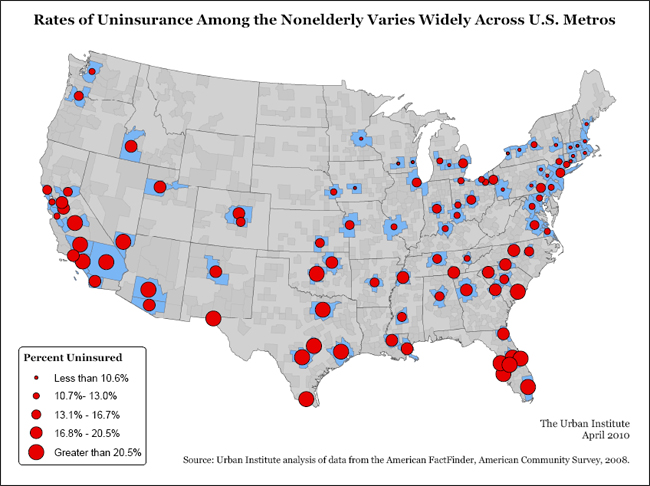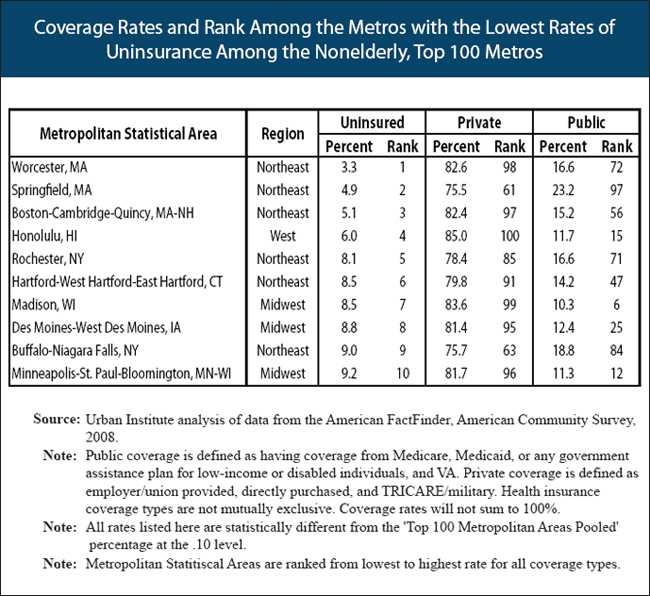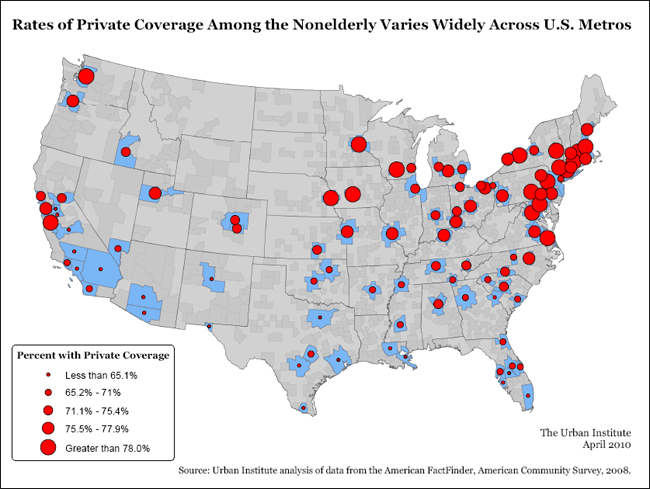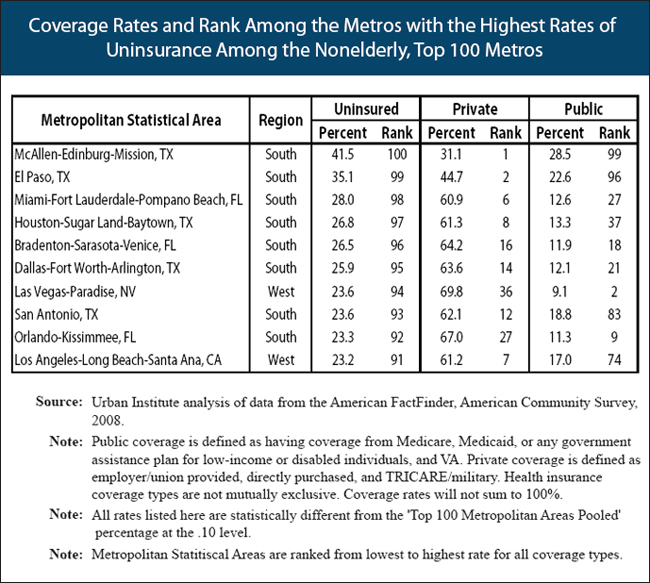
|
|
Health Insurance Coverage Benefits and Challenges of Health Reform Will Vary Across MetrosThe Patient Protection and Affordable Care Act passed in March is projected to expand health insurance coverage to over 30 million uninsured people. Health reform will have its biggest effects in areas where large shares of the population are uninsured. Since almost two-thirds of the nation's uninsured live in the top 100 metro areas, it is important to consider possible variation in impacts of health reform across metros. We use the latest American Community Survey data to identify metro areas where residents stand to benefit the most from expansions in health insurance coverage that will result from health care reform. Overall, 16.6% of the nonelderly population in the top 100 metro areas are uninsured, essentially the same as the 17.0% rate for the nation as a whole. But that average masks substantial differences across areas. Nonelderly residents in McAllen-Edinburg-Mission, TX (which has the highest rate) are more than ten times as likely to be uninsured than residents of Worcester, MA (which has the lowest rate). In the ten metro areas with the lowest rates, fewer than 9.2% of nonelderly residents are uninsured, while in the ten metros at the other extreme, uninsurance rates exceed 23.2%. Metros with the lowest rates of uninsurance are concentrated in the Northeast. Of these, three are in Massachusetts (Worcester; Springfield; and Boston-Cambridge-Quincy) and one is in Hawaii (Honolulu), the only two states in the nation that have universal health care laws. Metros with the highest rates of uninsurance are concentrated in the South, including the only two metros where uninsurance rates exceed 30%, both in Texas (McAllen-Edinburg-Mission and El Paso). But even within regions, we see substantial differences between metros. It appears that underlying differences in rates of private health coverage provide at least part of the explanation for differences in uninsurance rates across metro areas. Private coverage offered through work is the single most important source of health insurance coverage for Americans, but access to employer-base coverage varies across the country, depending on the characteristics of the firms and workers in a particular area. Overall, the rates of private coverage and uninsurance are very highly correlated across the top 100 metro areas (correlation coefficient of ?.90), indicating that in metro areas where private coverage is high, uninsured rates tend to be low. Of the ten metro areas with the highest rates of private coverage, seven are also among the ten with the lowest rates of uninsurance, and of the ten metro areas with the lowest rates of private coverage, five are among the ten with the highest rates of uninsurance. Metro areas with low rates of private coverage not only have higher rates of uninsurance, but also higher rates of public coverage, suggesting the public coverage fills in some of the gaps in private coverage. The relationship between private coverage and public coverage is strong (correlation coefficient of ? .65) though not quite as strong as the relationship between private coverage and uninsurance. For example, among the ten metro areas with the lowest rates of private coverage, nine are among those with either the highest rates of uninsurance or public coverage, or both. These differences in uninsured rates suggest that some metro areas will be more strongly affected by health care reform than others. Metro areas that currently have the highest uninsured rates will likely benefit disproportionately from the Medicaid expansions and the federal subsidies for coverage that are slated to go into effect in 2014. However, metro areas with a large numbers of uninsured who can not obtain coverage because of their immigration status or affordability issues may experience smaller increases in coverage. And metro areas where coverage increases most dramatically can also expect to see big increases in the demand for health care services. Communities with high uninsured rates today should be assessing their provider capacity to ensure that they will be able to meet the increased demand for health care that is likely to result from health care reform. And as health reform takes effect, it will be important to track uninsured rates on an ongoing basis to assess where the remaining uninsured people live and whether they have access to safety net health care providers. |
Expert Feedback
Send us your comments to help further the discussion. Share
Commentaries
|









 Genevieve Kenney
Genevieve Kenney